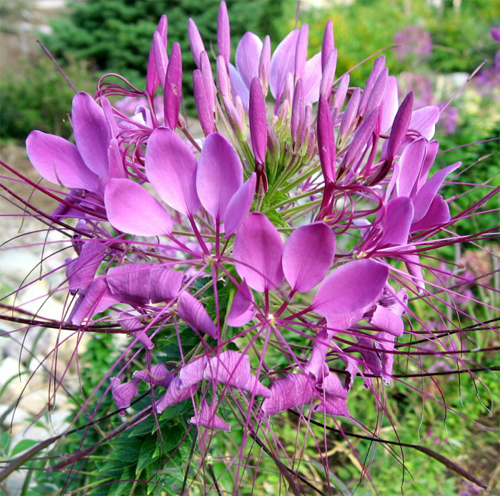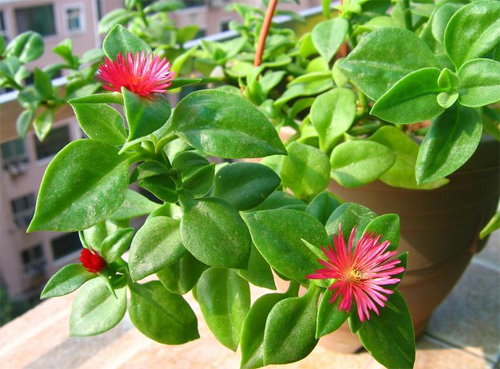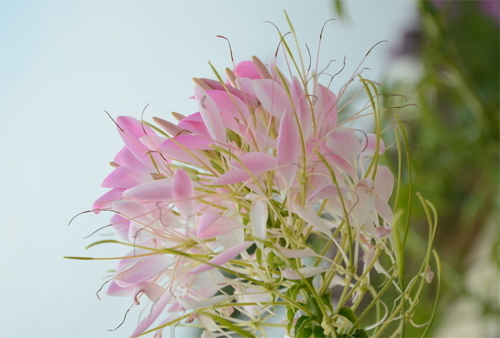The planting method of drunken butterfly flower: how long is the florescence?
Drunken butterfly flower itself is very lovely, blooming flowers have tentacles, and there are many small flowers on a flower, what is the planting method of drunken butterfly flower? How long is the flowering period of drunken butterfly flower?

The planting method of drunken butterfly flower:
1. Soil selection
Raise drunken butterfly flower do not need too fastidious soil, generally use humus soil or garden soil to add 3 fine sand on it, but should pay attention to drunken butterfly flower root system is developed, so want deeper basin (30 centimeters above).
2. Proper watering
It is more drought-resistant, so in addition to the basin soil that keeps moist at the seedling stage, it is also watered every day in summer. In other seasons, the basin soil is dry and then watered. Of course, it is not watered on cloudy and rainy days, do not water at night, and it is better to be dry at night.
3. Suitable temperature and light
It likes plenty of sunshine, heat-resistant, but semi-overcast, not cold-resistant, summer will enjoy flowering, growth, will die after frost, the most suitable temperature is 20-33 degrees.
4. Introduction to basin change maintenance
Pot maintenance is best in the bottom layer covered with ceramsite or broken stone, covered with organic fertilizer, 1 cm to 2 cm, covered with soil, and then planted with plants, so that plants can grow better.
Garden soil and fine sand can be used at 3:1, and peat soil plus perlite at 1:1 is fine.
5. Proper fertilization
The above has talked about how to use the base fertilizer, usually after planting will be applied once a thin fertilizer, a small amount.
Generally speaking, it does not like to fertilize too much, usually give thin liquid fertilizer twice in spring, remember not to fertilize at night, it is best in the morning, do not water at night, leaves and flowers should be kept dry at night.
6. The importance of picking the heart
Generally, the heart is picked twice after flowering, and the potted plant should be cultivated in this way so that it will not grow to more than one meter tall and can promote branches.
Coring is usually carried out twice before flowering to promote the germination of more flowering branches: one to two weeks after potting, or when the seedling is 6-10 cm tall and has 6 leaves, remove the terminal bud and retain 4 leaves.
Wait for its branches to grow to about 7 cm, and then pick the heart, remove its lateral buds and terminal buds, and leave four leaves. (take care to pick off the residual flowers after flowering)
How long is the flowering period of drunken butterfly:
Late summer and early autumn.
This is the end of the introduction on the planting method and florescence of drunken butterfly flower, so hurry up to raise one in your own home.
The planting method of drunken butterfly how to grow drunken butterfly
Drunken butterfly flower, also known as butterfly grass, purple dragon beard, spider flower, etc., is a 2012 herb of cauliflower family. It is native to tropical America and cultivated in tropical to temperate zones all over the world. It is not wild in China, and it is common in major cities. Flower beds and borders can be arranged in summer and autumn, and they can also be dwarfed as potted plants. Let's take a look at the planting method of drunken butterfly flowers.
The growth habit of drunken butterfly flower
Drunken butterfly flower has strong adaptability, sex likes high temperature, is more resistant to summer heat, and avoid cold. Like plenty of sunshine, semi-shaded land can also grow well. The fertile soil with sufficient water and fertilizer, the fertile soil with sufficient water and fertilizer, the soil with medium fertility can grow well, and the sandy loam or clayey soil or alkaline soil can grow poorly. Like moist soil, but also more resistant to drought, avoid stagnant water.
The breeding method of drunken butterfly flower
1. Sowing: the drunken butterfly was sowed and propagated in the middle of April and the seeds were sown in the open field seedbed, and the seedlings emerged neatly. The seedlings grow slowly, need time after sowing, transplant when they have 2-3 true leaves, plant or pot in June, fertilize once a half month during the growing period, if fertilized too much, it is easy to grow plants and affect plant shape and flowering, generally spring sowers blossom in autumn, autumn sowers watch flowers indoors in winter and spring.
2. Cutting: nutritious soil or river sand, peat soil and other materials for drunken butterfly cuttings, the optimum temperature for cuttings to take root is 18: 25 ℃, lower than 18 ℃, the relative humidity of the air must be kept at 75% 85%, the humidity can be increased by spraying the cuttings, at the same time, the sun must be covered by 50% 80%, and then the shading net is gradually removed after the root system grows.
The planting method of drunken butterfly flower
1. Soil: drunken butterfly flowers do not need special soil, preferably sandy soil containing humus with good drainage. The root system is more developed, and the basin should be slightly deeper and larger, with a basin diameter of 20 cm to 30 cm. Except for poor growth in alkaline soil, it can grow in sandy soil and clayey soil, and grow best in slightly acidic sandy loam. Rotten leaf soil and vegetable garden soil can be used to cultivate soil, which requires loose soil and good drainage.
2. On the basin: when installing the pot, put a coarse-grained matrix or ceramsite 2cm thick at the bottom of the basin as a filter layer, sprinkle a layer of fully mature organic fertilizer as base fertilizer with a thickness of about 1cm, then cover it with a substrate, which is about 1cm thick, and then put in the plant to separate the fertilizer from the root system and avoid root burning.
3. Fertilization: when transplanting, the drunken butterfly seedlings first dig the planting hole, sprinkle a layer of organic fertilizer at the bottom of the planting hole as the base fertilizer, with a thickness of about 46.6 cm, and then cover a layer of soil and put it into the seedlings to separate the fertilizer from the root system and avoid root burning. After putting it into the seedling, backfill the soil, cover the root system, step on the soil with your feet, water it once, and apply thin fertilizer once in the initial planting.
4. Heart picking: drunken butterflies generally pick their hearts twice before flowering to promote the germination of more flowering branches. One to two weeks after potting, or when the seedling is 6-10 cm tall and has more than six leaves, remove the top tip and retain the lower 3-4 leaves to promote branching. After 3-5 weeks of the first coring, or when the lateral branch grows to 6-8 cm long, the second coring is performed, that is, the top tip of the lateral branch is removed and the 4 leaves under the lateral branch are retained.
5. Watering: drunken butterfly flowers can withstand drought, but grow better when given greater air humidity. Water them every day in midsummer and water them thoroughly. Like higher air humidity, air humidity is too low, will accelerate the withering of a single flower. Also afraid of rain, need to keep the leaves dry at night. The optimum relative humidity of the air is 65-75%.
6. Diseases and insect pests: drunken butterfly flowers are often harmed by leaf spot and rust. Leaf spot disease is sprayed with 50% tromethamine wettable powder, and rust can be sprayed with 3000 times alcohol. Drunken butterfly flowers are prone to Lepidoptera pests at the seedling stage, so the insecticide avermectin 4000 times can be sprayed on the leaves.
Cultivation methods of drunken butterfly flower
Drunken butterfly flower
The main results are as follows: (1) morphology and ornamental characteristics. Drunken butterfly, also known as Phalaenopsis, is an annual herbaceous flower of the genus Brassica. The plant is more than 1 meter high and is a large herbaceous flower. The flower shape is beautiful and chic, petals reunited like a fan, stamens protruding like claws, shaped like butterflies flying, delicate and colorful, pink at the beginning, turning pink, then purplish red, a flower with multiple colors, with nectaries, often intoxicating the butterflies, hence the name.
Suitable for parks, large flower beds, courtyards and other places to grow, quite prosperous landscape, can be planted in individual or small clumps, can also be planted with shrub flowers, is an important flower planted in the ground. Can also be cultivated as cut flowers, used for flower baskets, vases and so on. Dwarfed plants can be planted as potted flowers.
(2) Origin and ecological characteristics. Drunken butterfly flower is native to tropical America and is often introduced and cultivated in various parts of our country. Strong adaptability like high temperature, more resistant to summer heat, avoid cold, like plenty of sunshine, semi-shaded land can also grow well. The fertile soil with sufficient water and fertilizer is not demanding on the soil, and the plant is tall; generally, the soil with medium fertility can also grow well; the sandy loam or clayey soil or alkaline soil grows poorly, likes moist soil, is more resistant to drought, and avoids stagnant water.
(3) Culture technology. The fruit is slender and mature in late summer and early autumn. the seeds are fine and dry, and the bags are stored in the shade or in the refrigerator. Precocious seeds can be picked and sown, and flowers can be seen at the end of autumn and the beginning of winter. Generally, the seeds are stored over the winter, sown in early spring, watch flowers in summer or sow at the end of spring, and watch flowers in summer and autumn. When the seeds germinate, the temperature should be above 20 ℃, and the seeds should be sowed in a plastic shed in early spring before they can germinate neatly. If the temperature is suitable, it can germinate about 1 week after sowing. Higher temperature is needed in the growing period, and the suitable temperature is 20: 32 ℃. When the seedlings produce 2-4 true leaves, they can be divided and planted. The root system is well developed and the survival rate of transplanting is high. Applying sufficient basal fertilizer during planting, bud formation and flowering stage, and topdressing for 2 or 3 times can prolong the flowering period. For potted plants, the terminal buds were removed at the seedling stage and nitrogen fertilizer was controlled to dwarf the plants. For cut flowers, the plants can be slightly denser and lateral buds can be removed to promote the development of terminal bud inflorescences. The whole plant has sticky hair and less water consumption. except for more water in flowering stage, it can be irrigated or less watered at seedling stage, which is easier to manage.
- Prev

Can the culture methods and matters needing attention of peony orchid be eaten?
Peony hanging orchid is a kind of plant that many people like to cultivate, and it is also very delicate. What are the breeding methods and matters needing attention of peony hanging orchid? Can peony orchids be eaten? The cultivation methods and precautions of peony orchid: light and temperature, as mentioned above, it does not need too much light to blossom.
- Next

What is the price of the breeding method of drunken butterfly flower?
The drunken butterfly flower blossoms is also very good-looking, if it can be planted in a large area at home, it will be more beautiful, what is the breeding method of drunken butterfly flower? How much is the price of drunken butterfly flower? The breeding method of drunken butterfly flower: how to collect seeds? Drunken butterfly flower is very easy to bear fruit
Related
- Fuxing push coffee new agricultural production and marketing class: lack of small-scale processing plants
- Jujube rice field leisure farm deep ploughing Yilan for five years to create a space for organic food and play
- Nongyu Farm-A trial of organic papaya for brave women with advanced technology
- Four points for attention in the prevention and control of diseases and insect pests of edible fungi
- How to add nutrient solution to Edible Fungi
- Is there any good way to control edible fungus mites?
- Open Inoculation Technology of Edible Fungi
- Is there any clever way to use fertilizer for edible fungus in winter?
- What agents are used to kill the pathogens of edible fungi in the mushroom shed?
- Rapid drying of Edible Fungi

